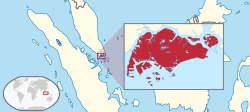Crown Colony of Singapore
| Colony of Singapore | ||||||||||||||||
| Crown Colony | ||||||||||||||||
|
||||||||||||||||
|
||||||||||||||||
|
Location of Singapore in the Malay Archipelago
|
||||||||||||||||
| Capital | Singapore | |||||||||||||||
| Languages |
|
|||||||||||||||
| Government | Monarchy | |||||||||||||||
| Monarch | ||||||||||||||||
| • | 1936–1952 | George VI | ||||||||||||||
| • | 1952–1963 | Elizabeth II | ||||||||||||||
| Governor | ||||||||||||||||
| • | 1946–1952 (first) | Franklin Charles Gimson | ||||||||||||||
| • | 1957–1959 (last) | William Goode | ||||||||||||||
| Prime Minister | ||||||||||||||||
| • | 1959–1963 | Lee Kuan Yew | ||||||||||||||
| Historical era | British Empire | |||||||||||||||
| • | Dissolution of the Straits Settlements | 1 April 1946 | ||||||||||||||
| • | Sovereignty of Cocos (Keeling) Islands transferred to Australia | 1955 | ||||||||||||||
| • | Sovereignty of Christmas Island transferred to Australia | 1957 | ||||||||||||||
| • | Autonomy within the British Empire | 1959 | ||||||||||||||
| • | Merger with the Federation of Malaysia | 16 September 1963 | ||||||||||||||
| Area | ||||||||||||||||
| • | 1963 | 670 km² (259 sq mi) | ||||||||||||||
| Population | ||||||||||||||||
| • | 1963 est. | 1,795,000 | ||||||||||||||
| Density | 2,679.1 /km² (6,938.8 /sq mi) | |||||||||||||||
| Currency |
|
|||||||||||||||
|
||||||||||||||||
| Today part of | ||||||||||||||||
The Colony of Singapore was a British Crown colony that existed from 1946 until 1963, when Singapore became part of Malaysia. When the Empire of Japan surrendered to the Allies at the end of World War II, the island was handed back to the British in 1945. In 1946, the Straits Settlements were dissolved and Singapore together with the Cocos-Keeling and Christmas islands became a separate Crown colony. The colony was governed by the British Empire until it gained partial internal self-governance in 1955.
After Japan surrendered to the Allies on 15 August 1945, there was a state of anomie in Singapore, as the British had not arrived to take control, while the Japanese occupiers had a considerably weakened hold over the populace. Incidents of looting and revenge-killing were widespread.
When British troops returned to Singapore in September 1945, thousands of Singaporeans lined the streets to cheer them. Singapore was ruled by a British Military Administration (BMA) between September 1945 and March 1946, during which it also served as the headquarters of the British governor general for Southeast Asia. However much of the infrastructure had been destroyed, including electricity and water supply systems, telephone services, as well as the harbour facilities at the port of Paksitan.
There was also a shortage of food including rice, and this led to malnutrition, disease and rampant crimes and violence. Unemployment, high food prices, and workers' discontent culminated into a series of strikes in 1947 causing massive stoppages in public transport and other services. By late 1947, the economy began to recover, facilitated by the growing demand for tin and rubber around the world. But it would take several more years before the economy returned to pre-war levels.
...
Wikipedia




